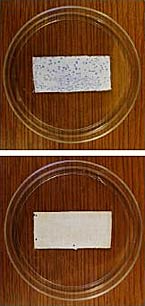Science Fiction
Dictionary
A B C D E F G H I J K L M N O P Q R S T U V W X Y Z
Anti-Viral Polymer Paints Flu Into A Corner

A remarkable anti-viral polymer can be applied like paint; it was developed by MIT's Alexander Klibanov. His intent is to develop a biocidal "paint" that can help reduce the spread of germs in public areas and hospitals.

(Bottom slide covered with alkylated PEI)
In the above illustration, a regular commercial glass slide (top) and another one coated with alkylated PEI "paint" (bottom) were sprayed with aqueous suspensions of Staphylococcus aureus cells, and then incubated. Some 200 bacterial colonies are seen on the unprotected slide—and only 4 on the protected one.
Staphylococcus aureus is described by the CDC as a "superbug" that is resistant to many types of antibiotics. Studies have shown that it can survive for weeks even on hard surfaces.
Klibanov writes:
Our recent studies have resulted in a new, “non-release” strategy for rendering common materials (plastics, glass, textiles) permanently microbicidal. This strategy, involving covalent attachment of certain long, moderately hydrophobic polycations to material surfaces, has been proven to be very effective against a variety of pathogenic bacteria and fungi, both airborne and waterborne. This work continues along with a quest for creating material coatings with anti-viral and anti-sporal activities.
Klibanov and his colleagues found that the prickly polymer worked on bacteria; they tested it with the smaller flu virus and found the same effects. They applied droplets of a flu solution to glass slips painted with the polymer. After a few minutes' exposure, they were unable to recover any active virus from the samples, meaning the coating reduced the pathogen's abundance by at least a factor of 10,000.
How does it work? In the case of bacteria, the polymer seems to gouge holes in a microbe's cell wall and spilling out its contents. The polymer molecules stay rigid because they are all positively charged and repel each other; they are like strands of hair standing on end from a static charge. The spikes have sufficiently few charges, however, that they can breach bacterial walls, which repel strongly charged molecules. The polymer probably neutralizes flu because the virus has an envelope around it suitable for spearing, Klibanov says.
Here are some other inventions that work on small organisms:
- First Motor Powered By Living Bacteria
Amazing new motor powered by hard-working bacteria. - Fungus Devours CDs
You thought you had enough to worry about - now there's a fungus that consumes CDs, metal and all. - Implanted Biothermal RFID Chips May Warn Of Avian Flu
Digital Angel, which makes VeriChips for humans, suggests using its thermal biosensing chips to check chickens for avian flu.
From Scientific American via MedGadget; read more about Alexander Klibanov.
Scroll down for more stories in the same category. (Story submitted 11/16/2006)
Follow this kind of news @Technovelgy.| Email | RSS | Blog It | Stumble | del.icio.us | Digg | Reddit |
Would
you like to contribute a story tip?
It's easy:
Get the URL of the story, and the related sf author, and add
it here.
Comment/Join discussion ( 0 )
Related News Stories - (" Medical ")
Brain Implant Is Able To Capture Your Inner Dialogue
'So you see, you can hide nothing from me.'
'Pregnancy Humanoids' From China Replace Moms
'A great many of these synthetic babies were made...' - David H. Keller, 1928.
Bacteria Turns Plastic Into Pain Relief? That Gives Me An Idea.
'I guess there's nobody round this table who doesn't have a Crosswell [tapeworm] working for him in the small intestine.'
Heart Patches Grown In The Lab Repair Hearts
I'm hoping that this procedure becomes a normal part of medical practice!
Technovelgy (that's tech-novel-gee!) is devoted to the creative science inventions and ideas of sf authors. Look for the Invention Category that interests you, the Glossary, the Invention Timeline, or see what's New.
Science Fiction
Timeline
1600-1899
1900-1939
1940's 1950's
1960's 1970's
1980's 1990's
2000's 2010's
Current News
iPhone Air Fulfils Jobs' Promise From 2007 - A Giant Screen!
'... oblongs were all over the floor and surfaces.'
ChatGPT Now Participates in Group Chats
'...the city was their laboratory in human psychology.'
iPhone Pocket All Sold Out!
'A long, strong, slender net...'
Did The Yautja Have These First?
What a marvel of ingenuity the little device was!
Jetson ONE Air Races Begin, Can Air Polo Be Far Behind?
'If you're one of those rarities who haven't attended a rocket-polo "carnage", let me tell you it's a colorful affair.'
Will Space Stations Have Large Interior Spaces Again?
'They filed clumsily into the battleroom, like children in a swimming pool for the first time, clinging to the handholds along the side.'
Mornine Sales Robot
'Robot-salesmen were everywhere, gesturing...'
Bipedal Robot Floats Gently While Walking
'a walking balloon proceeded with long strides of its aluminum legs...'
Musk Idea Of Cars Talking To Each Other Predicted 70 Years Ago
'My cars talk to one another.'
Elegant Bivouac Shelter Produces Water And Electricity
'There was nowhere on the planet where science and technology could not provide one with a comfortable home...'
X-Control Janus-1 A Suitcase Aircraft
'You will notice that it... fits the suitcase nicely.'
'AI Assistants' Are Actually Less Reliable For News
'Most men updated their PIP on New Year's Day...'
YES!! Remote Teleoperated Robots predicted by Technovelgy!
'...a misshapen, many-tentacled thing about twice the size of a man.'
Will Robots Ever Fold Landry?
Where have you gone, Mrs. Robinson?
Will AIs Give Better Results If You're Rude To Them?
'I said, "Listen up, motherf*cker.'
Cybertruck Robotic Arm F10 Drone Launch!
Drone away!
